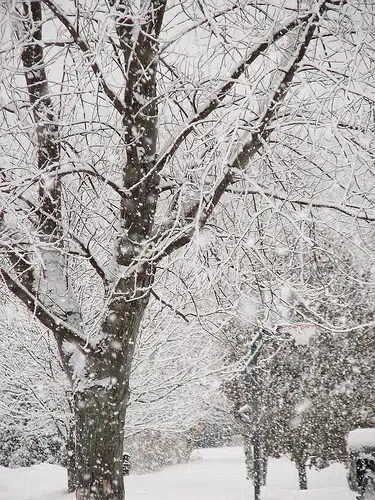The Tree Care Industry Association answers the question; Will snow on my trees harm them?
We all enjoy the appearance of freshly fallen snow on our landscape trees. It’s a seasonal decoration we can all appreciate.
On the other hand, “Snow is both friend and foe to trees and shrubs,” says Tchukki Andersen, BCMA, CTSP* and staff arborist with the Tree Care Industry Association (TCIA). “Snow loads can be very damaging, as we all know, but in many cases, snow also protects plants and their roots from extreme fluctuations in temperature that could damage or even kill them.”
Excess snow can damage trees and woody shrubs by bending, breaking and splitting them or causing them to fall or uproot.
Whether woody plants will be damaged in one of these ways depends upon several factors. Coniferous evergreens, for instance, can bear more snow weight than broadleaf evergreens. A tree’s form can also determine how well it will withstand heavy snow. For example, pine (low altitude), spruce and fir trees with spreading branches are more likely to be damaged by heavy snowfall than trees with more steeply angled branches.
Arborvitae – evergreen shrubs with tall, narrow growth habits planted in hedges or as foundation screens – are good examples of plants that don’t handle heavy snow well. They tend to grow tall, with multi-stemmed branches that separate under the weight of snow. Too often, they do not return to their upright form after the snow melts, and become permanently disfigured.
“Try to avoid planting arborvitae species in areas that get lots of heavy, wet snow,” Andersen advises. “Also, make sure not to plant them near buildings where snow accumulates on the roof, then falls in large piles. A better choice would be smaller, rounded, woody-stemmed plants, but be certain to give them enough space above and below ground to grow away from the building.”
A tree’s branch structure is also a factor in whether it will be damaged by ice storms. A tree with strong, right-angle branches will have less trouble than one with narrow, more vertical branch unions.
The type of snow is an important factor in potential damage to trees. Obviously, wet snow is more damaging because it is heavier. The time of season for snowfalls can also be a factor. With a wet snow in March, when there are no leaves on the branches, the tree may be able to withstand damage pretty well. That same snow in late spring or early fall, when the tree is filled with leaves, could add unbearable weight.
But, as mentioned above, not all snow on woody plants is a reason to panic. On the plus side of things, snow helps insulate the ground, moderating temperature changes for the soil below. This keeps the ground from heating and cooling as air temperatures fluctuate. Heating and cooling often cause the ground to heave, which can be damaging to roots. Keeping the ground temperature stable is more conducive to healthy roots.
“Finally, a little breakage isn’t always bad,” insists Andersen. “Nature prunes trees, too. Wet snow may break off small twigs and broken or dead branches. In that way, it can do a good job of pruning. Just follow up with some cleaning cuts.”
Find a professional
A professional arborist can assess your landscape and work with you to determine the best course of action to care for and maintain the trees and shrubs in your landscape. Contact the Tree Care Industry Association, a public and professional resource on trees and arboriculture since 1938. TCIA has more than 2,400 member tree care firms and affiliated companies. All member tree care companies recognize stringent safety and performance standards and are required to carry liability insurance and workers’ compensation insurance, where applicable.
TCIA has the nation’s only Accreditation program that helps consumers find tree care companies that have been inspected and accredited based on: adherence to industry standards for quality and safety; maintenance of trained, professional staff; and dedication to ethics and quality in business practices. An easy way to find a tree care service provider in your area is to use the “Find A Tree Care Company” program. You can use this service by calling 1-800-733-2622 or by doing a ZIP Code search on www.treecaretips.org.











